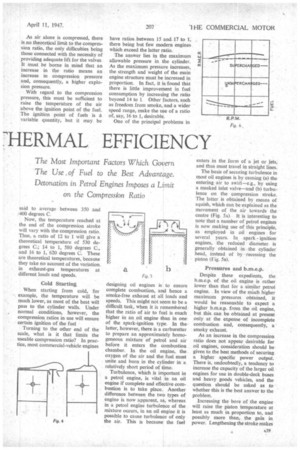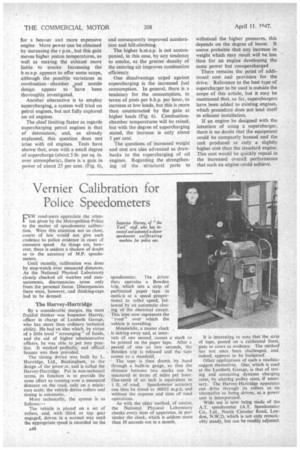COMPRESSION RATIO and THERMAL. EFFICIENCY
Page 40

Page 41

Page 42

If you've noticed an error in this article please click here to report it so we can fix it.
IT is generally appreciated that the compression ratio of an internalcombustion engine has a direct bearing on thermal efficiency, but what is not so frequently realized is that the same factors do not apply equally to petrol and oil engines. The compression ratio is usually defined as the ratio of the total volume to the clearance volume (see Fig. 1), this being the simplest conception, and the one normally quoted by the manufacturer.
Some authorities, however, calculate the volume of the cylinder after the inlet valve has closed, arguing that the compression stroke is not effective until this valve is on its seating. As on the majority of engines closure of the inlet valve does not take place until the crank has turned some 45 degrees or more past bottom dead centre, this represents a reduction in the compression volume, and a consequent decreased effective compression ratio.
, A Flattening Curve In Fig. 2 is shown the relationship between the compression ratio and the ideal thermal efficiency. The term " ideal " is used as certain assumptions are made which do not obtain in an actual engine. The point to note, however, is that, although this efficiency increases with the compression ratio, the rate of increase becomes less marked as the ratios get higher.
For instance, by increasing the ratio from 6 to 8 there is a gain in efficiency of 5 per cent., but from 12 to 14 the increase is only 2 per cent. This has an important bearing on the compression ratios of petrol engines, as compared with oil engines.
Before dealing with the question of the relative values of the ratios for the two types of engine, it may be as
practice, the thermal efficiency of most petrol engines does not vary greatly, being approximately 25 per cent., based on the brake horsepower.
The corresponding efficiency for the oil engine is about 35 per cent., which accounts for the muchimproved m.p.g. figure of this type of engine. Instead of quoting the efficiency figure, manufacturers give the fuel consumption in pints per b.h.p. per hour. This is, of course, directly dependent on the thermal efficiency, and has the advantage of showing how this figure varies with the engine speed.
It would appear that the simplest way to increase the efficiency of both types of engine would be to use higher compression ratios. In the case of petrol engines, there is a definite tendency for post-war cars to employ ratios of, say, 7 to 1, compared with about 6 to 1 for pre-war units. The limiting factor is detonation—or pinking, as it is usually called—the effects of which are to cause increased combustion-chamber temperature, and eventually a falling
war, may not be so happy at the prospect. It is generally agreed, however, that high-octane fuels are satisfactory in engines designed to use them. There is no advantage in employing such fuels in lowor medium compression engines, in fact, there are disadvantages in so doing.
Head Design Apart from the octane rating, cylinder-head design has a strong bearing on the tendency of an engine to detonate. The main essential is to ensure that the final burning of the charge is not spontaneous. This is usually achieved by presenting the largest surface area to this part of the charge, and similar methods can be employed on both side-valve and o.h.v. engines (Fig. 4). The shaded portions in the diagram represent the final burning areas, which, by restricting the temperature rise, prevent spontaneous ignition.
Turning now to the oil engine, the problem of detonation, as such, does not arise. A phenomenon known as Diesel knock can occur, but this is associated with the delay period, and not directly with the compression ratio. said to average between 350 and 400 degrees C.
Now, the temperature reached at the end of the compression stroke will vary with the compression ratio. Thus, a ratio of 12 to I will give a theoretical temperature of 530 degrees C.; 14 to 1, 580 degrees C., and 16 to 1, 620 degrees C. These are theoretical temperatures, because they take no account of the variation. in exhaust-gas temperatures at different loads and speeds.
Cold Starting When starting from cold, for example, the temperature will be much lower, as most of the heat will pass to the cylinder walls. Under normal conditions, however, the compression ratios in use will ensure certain ignition of the fuel Turning to the other end of the scale, what is it that limits the useable compression ratio? In practice, most commercial-vehicle engines designing oil engines is to ensure complete combustion, and hence a smoke-free exhaust at all loads and speeds. This might not seem to be a difficult task, when it is remembered that the ratio of air to fuel is much higher in an oil engine than in one of the spark-ignition type. In the latter, however, there is a carburetter to prepare an approximately homogeneous mixture of petrol and air before it enters the combustion chamber. In the oil engine, the oxygen of the air and the fuel must unite and burn in the cylinder in a relatively short period of time.
Turbulence, which is important in a petrol engine, is vital in an oil engine if complete and effective combustion is to take place. Another difference between the two types of engine is now apparent, as, whereas in a petrol engine turbulence of the mixture occurs, in an oil engine it is possible to cause turbulence of only the air. This is because the fuel enters inin the form of a jet or jets, and thus must travel in straight lines.
The basis of securing turbulence in most oil engines is by causing (a) the entering. air to swirl—e.g., by using a masked inlet valve—and (b) turbulence on the compression stroke. The latter is obtained by means of squish, which can be explained as the movement of the air towards the centre (Fig. 5A). It is interesting to note that a number of petrol engines is now making use of this principle, as employed in oil engines for several years. In spark ignition engines, the reduced diameter is generally obtained in the cylinder head, instead of by recessing the piston (Fig. 5a).
Pressures and ban.e.p.
Despite these expedients, the b.m.e.p. of the oil engine is rather lower than that for a similar petrol engine. In view of the InUch higher maximum pressures obtained, it would be reasonable to expect a higher b.m.e.p. from the oil engine, but this can be obtained at present only at the expense of incomplete combustion and, consequently, a smoky exhaust.
As an increase in the compression ratio does not appear desirable for oil engines, consideration should be given to the best methods of securing a higher specific power output. There is, undoubtedly, a tendency to increase the capacity of the larger oil engines for use in double-deck buses and heavy goods vehicles, and the question should be asked as to whether this is the best answer to the problem.
Increasing the bore of the engine will raise the piston temperature at least as much in proportion to, and possibly more than, the gain in power. Lengthening the stroke makes for a heavier and more expensive engine More power can be obtained by increasing the r p.m., but this gain means higher piston temperatures, as well as making the exhaust more liable to smoke Increasing the b.m.e.p. appears to offer some scope, although the possible variations in combustion chamber and nozzle design appear to have been thoroughly investigated.
Another alternative is to employ supercharging, a system well tried on petrol engines, but not fully explored on oil engines.
The chief limiting factor as regards supercharging petrol engines is that of detonation, and, as already explained, this question does not arise with oil engines. Tests have shown that, even with a small degree of supercharge (about 5 lb. per sq. in. over atmospheric), there is a gain in power of about 25 per cent. (Fig. 6), and consequently improved acceleration and hill-climbing.
The higher b.m.e.p. is not accompanied, in this case, by any tendency to smoke, as the greater density of the entering air improves combustion efficiency.
One disadvantage urged against supercharging is the increased fuel consumption. In general, there is a tendency for the consumption, in terms of pints per b.h.p. per hour, to increase at low loads, but this is more than counteracted by the gain at higher loads (Fig. 6). Combustionchamber temperatures will be raised, but with the degree of supercharging stated, the increase is only about 5 per cent.
The questions of increased weight and cost are also advanced as drawbacks to the supercharging of oil engines. Regarding the strengthening of the structural parts to withstand the higher pressures, this depends on the degree of boost. It seems probable that any increase in weight which may result will be less than for an engine developing the same power but unsupercharged
There remains the point of additional cost and provision for the drive. Reference to the best type of supercharger to be used is outside the scope of this article, but it may be mentioned that, so far, superchargers have been added to existing engines, which procedure does not lend itself to efficient installation.
If an engine be designed with the intention of using a supercharger, there is no doubt that the equipment could be compactly housed and the unit produced at only a slightly higher cost than the standard engine. This cost would be quickly repaid in the increased overall performance that such an engine could achieve.




































































